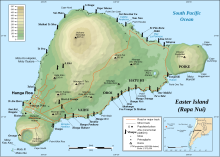Terevaka
Appearance
Coordinates: 27°5′4″S 109°22′46″W / 27.08444°S 109.37944°W Coordinates: Extra unexpected parameters
| Terevaka |
|---|
Maunga Terevaka is the largest, tallest (Template:Unit m) and youngest of three main extinct volcanoes that form Rapa Nui (Easter Island) (a Chilean island in the Pacific Ocean). Several smaller volcanic cones and craters dot its slopes, including a crater hosting one of the island's three lakes, Rano Aroi.


While Terevaka forms the bulk of Easter Island, the island has two older volcanic peaks; Poike which forms the eastern headland and Rano Kau the southern. Terevaka last erupted in the Pleistocene and is less than 400,000 years old. Its lava field at Roiho has been dated at between 110,000 and 150,000 years old. Terevaka is rather difficult to climb, and is only accessible by foot or horse. It is very windy at the top.
See also
References
External links
- Guide to Easter Island from the Easter Island Foundation
- Old photos of Rano Aroi (upper right)
